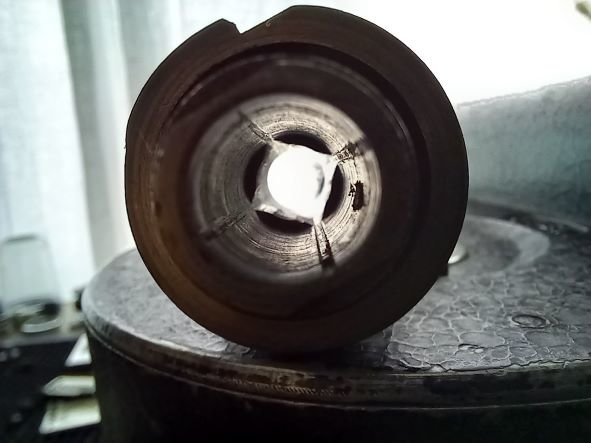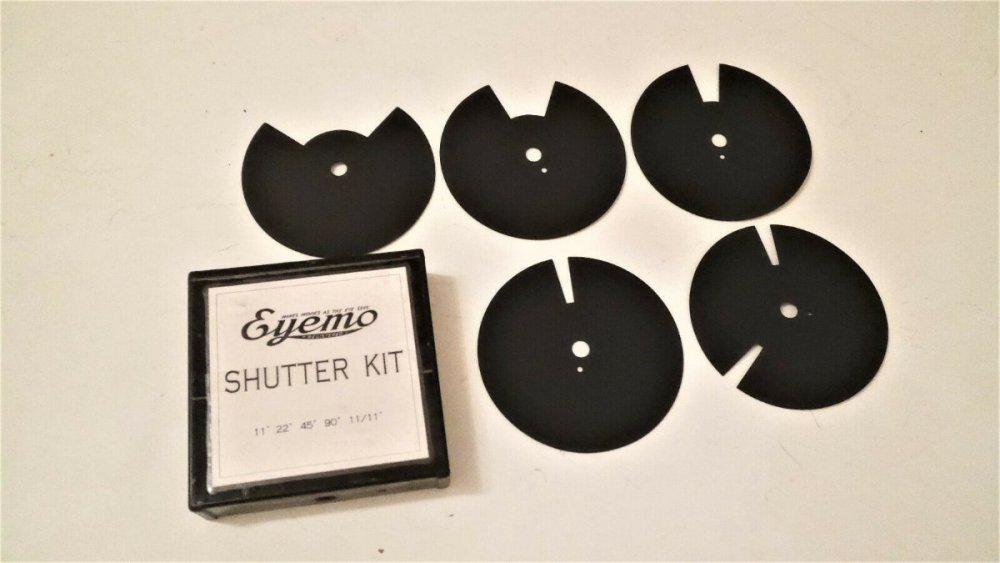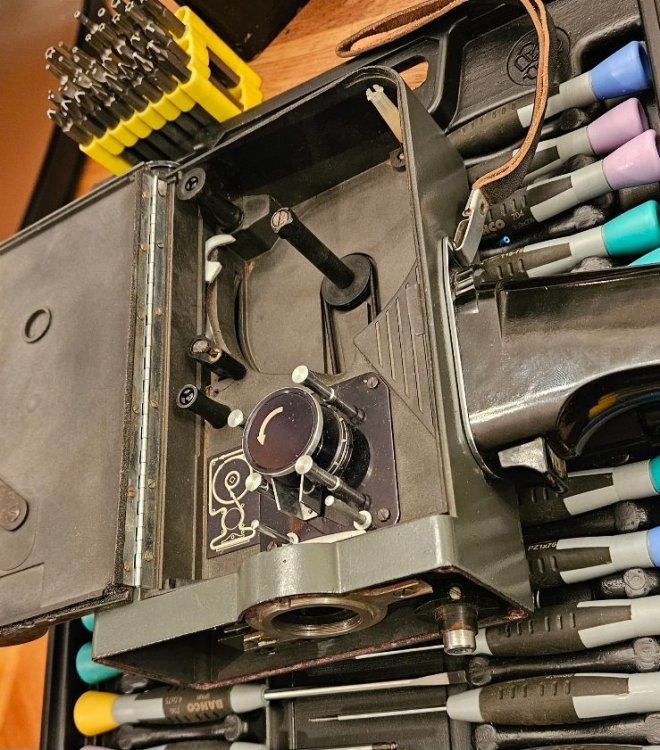-
Posts
2,587 -
Joined
-
Last visited
Everything posted by Simon Wyss
-
The vertical lines you see in the finder are thin sheet baffles that sit in front of the ground glass. They’re there to prevent light reflected from the ground glass to reach the film.
-

WTB: Leica M to C Mount
Simon Wyss replied to Zack Mahar's topic in Marketplace Listings Under $200 / €200
https://www.ebay.ch/itm/167296741830?_skw=c+mount+leitz&itmmeta=01JQ20S24887XN551YVEZZY06J&hash=item26f3a9b1c6:g:BLIAAOSwjFFno8SW&itmprp=enc%3AAQAKAAAA0FkggFvd1GGDu0w3yXCmi1cNnPhYCZW%2F25%2BcsrrCMUdK%2BI6CbxSWQtb%2ButPFNoYCDmBzQicdpOhR4pYCWcpVwdZXFc%2B4YXE9C17GslxvcReeYVkUAhm7ueq5hNlbMFULDd1iOrVvoIBDRkl4%2FWguu%2FvD5kRAZbLi4szzTNJFfh3PO4pquQXxfmPXy1Iuu7BXfx8fImIGvW2aDnnq8X8f8MC9rvJ%2F4ztr%2FFxKvrSwS2e%2BIIeGIH6I2iJO5B3D6qWX4g%2FaqfSw5MwFLcBjj%2FezPPM%3D|tkp%3ABk9SR6qi5MC4ZQ -
Automatism is one thing man has had enough of, at least me.
-
I’d wish you wrote the name Richter correctly for a beginning.
-

Looking for guidance on my Beaulieu r16 Faceplate.
Simon Wyss replied to chris layton's topic in 16mm
What is it that makes you not want C-mount lenses? This camera was made for them and you can find C-mount optics that will satisfy every wish there is.- 1 reply
-
- beaulieu r16
- novice
-
(and 1 more)
Tagged with:
-

Best 16 mm Camera for shooting action shots outdoors
Simon Wyss replied to George Hill's topic in General Discussion
For action shooting, OP writes ski films, the following aspects ought to be considered. frame rates; is acceleration wanted, is slow motion desired shutter opening per cycle; is smooth movement rendering important or less blur in favour of a more staccato movement acceptable how much film shall be loadable; 50 to 400 feet volume, weight, ruggedness, serviceability; from a GIC 16 (loads 50 feet, runs at 16 fps only, has 140 degrees shutter opening angle, has fixed register tongue, C-mount thread, can take lightweight lenses) to the Eumig C 16 (runs up to 64 fps, has 160 degrees shutter opening, built-in Eumigar 25-1.9, an Ernostar variant, semi-automatic iris) to a brand new Y16 (planned to appear this year or next). In the cold (skiing) you will be better off with a spring drive. No worry about batteries A 50-foot magazine loading Bell & Howell Filmo Auto Load can do the trick because it takes C-mount lenses, speeds up from 16 to 64, weighs little. Certainly, for longer during takes you want an electric drive or a Victor 3/4/5 that runs over 55 seconds at speed 24. The Victor is lighter in weight than a Filmo 70, takes 100 feet of film, younger models go up to 72 fps. Quite reliable is an ETM-P 16 from France, all steel mechanism, ground glass, high-speed model runs 120 fps top. Only a Filmo 70 Super-Speed goes faster, 128 fps. -
They are according to this site. https://industrycamera.net/equipment/35-mm-vintage-lenses/kowa-cine-prominar-lenses/
- 4 replies
-
- vintagelens
- kowa
-
(and 2 more)
Tagged with:
-

Best 16 mm Camera for shooting action shots outdoors
Simon Wyss replied to George Hill's topic in General Discussion
Eumig C 16 -

Cosmicar Television 150mm f/3.2 C-Mount Lens Quality
Simon Wyss replied to Matthew Hall's topic in Lenses & Lens Accessories
From my understanding of Cosmicar branded Pentax, Pentacon, Meyer lenses you have a Petzval four-glass system. The Schneider Tele-Xenar is a five-glass design having the Sonnar front group. Quite different but both will give sharp images, the Cosmicar going soft in the corners at f/3.4 to about f/5.6. -

How often should I service Arriflex 16S?
Simon Wyss replied to Ivan DImitrov Alexandrov's topic in 16mm
These cameras, if serviced correctly, can be run for years with a little oil every 5,000 feet of film. 100,000 feet in two years would mean 125 magazine loads of 400 ft. a year. That’s two and a half magazines a week, television consumption of the time. After ten years a service is indicated anyways.- 3 replies
-
- arriflex 16s.
- service
-
(and 1 more)
Tagged with:
-
It does and you can do it the wrong way by either method. Canister vertically gravity distorts the mass unless the film is wound tight on a core. That films need air is overlooked. For short term entreposage and sorting the better method, see an editing room. Can horizontally the support must be well flat, else entire rolls are distorted and or may have kinked edges. It’s easy to ensure that the convolutions have air between them and the core doesn’t play a role. This is for long-time archiving.
-
Just one entry: https://www.jwwinco.com/en-us/products/1.3-Adjusting-with-handwheels-and-cranks/Spoked-handwheels/GN-950.1-Cast-Iron-Spoked-Handwheels-with-Large-Hub-with-or-without-Revolving-Handle
-
Var så god.
-
It’s always possible but you won’t see an image because the subcoating remains substantially opaque, a thin layer that contains manganese dioxide. This acts as a countermeasure to stray light reflected by the base plastic or antihalation agent. It must be bleached and thus made soluble. The clearing bath dissolves it out the film like the fixing bath dissolves the remaining silver compounds.
-
Indeed. A high-contrast recipe isn’t necessary. A HQ rich developer will do fine. Dichromate bleach, though, a clearing bath, then under water for second exposure with incandescent light. Same developer again, rinse, and fixing bath
-
Svema OC 50 probably
-

Bolex H16 - Reflex or Non-Reflex?
Simon Wyss replied to Roberto Colapietro's topic in Camera Operating & Gear
Sometimes I wonder . . . As stated a Paillard-Bolex H reflex finder camera bears the word REFLEX. There is one model of which a reflex version never existed, the H 9. -

Anyone Want to Take a Guess at My Eyemo's Shutter Angle?
Simon Wyss replied to Aaron Martin @ OH's topic in 35mm
-

Bolex H16 - Reflex or Non-Reflex?
Simon Wyss replied to Roberto Colapietro's topic in Camera Operating & Gear
Attention, side finders are frequently found with Reflex models. They are a useful accessory for situations when the reflex view is dim. -

Bolex H16 - Reflex or Non-Reflex?
Simon Wyss replied to Roberto Colapietro's topic in Camera Operating & Gear
A Paillard-Bolex H reflex finder camera (1956 to 1969) is lettered Reflex. A Bolex H reflex finder camera (from after January 1st, 1970) bears the designation Reflex or SB or SBM or EBM or EL. The Bolex 16 Pro have a reflex finder, too. This one reads H 16 M. No Reflex -
Also disassembled parts. Finder must be complete. PM
-
Joking aside, the lenses look worse than they probably are. Wrap each in a plastic bag, and put them in protective boxes. A pro can work them up. The camera body may need to be replaced. Decisive is the state of things inside, how much rust there is and where, quality of mainspring, wear on gear train. The rest can be groomed. It’s a REX 1 from between 1956 and 1960.
-
Wonderful, I’m awaiting an order in order that I can note six grand on the bill.
-
https://www.filmvorfuehrer.de/topic/24892-darf-ich-vorstellen-kiew-16-alpha-die-leichteste-und-lauteste-federwerk-reflexsucherkamera/#comment-278877 Pretty straightforward, screws in film chamber. Why don’t you first remove the handgrip?







